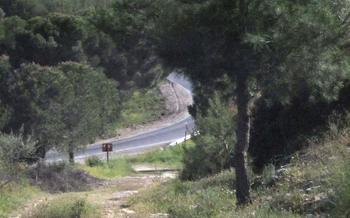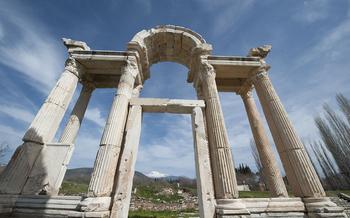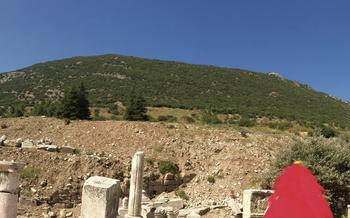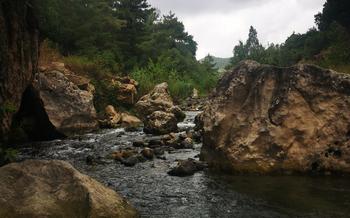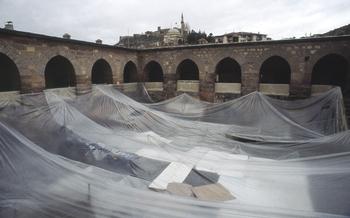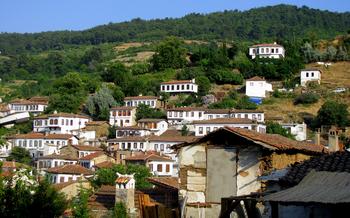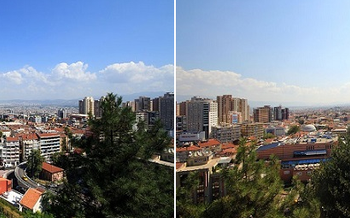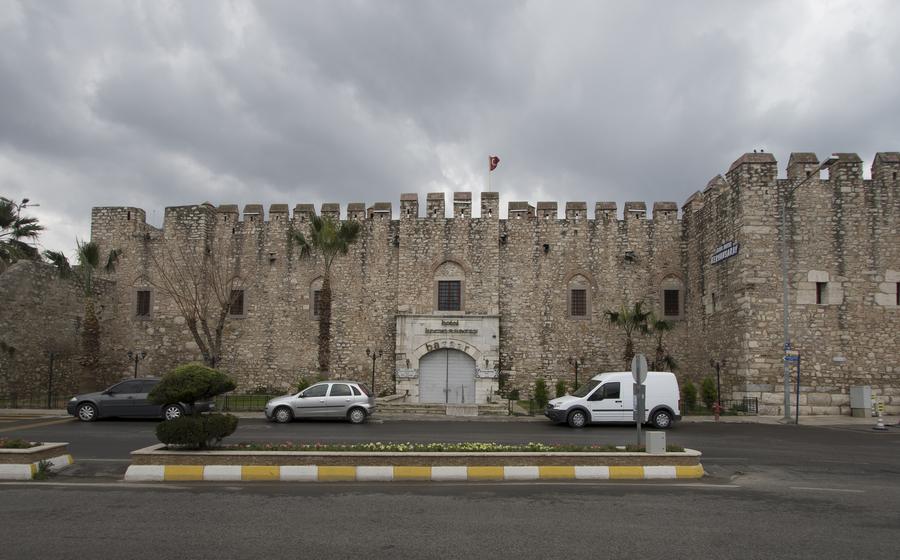
Kusadasi Caravanserai
- Kusadasi Caravanserai: A Historical Gem
- Exploring the Courtyard
- The Caravanserai's Rooms
- The Caravanserai's Common Areas
- The Caravanserai's Mosque
- The Caravanserai's Market
- The Caravanserai's Bathhouse
- The Caravanserai's Stables
- The Caravanserai's Kitchen
- The Caravanserai's Museum
- The Caravanserai's Events and Festivals
- The Caravanserai's Surroundings
- The Caravanserai's Accessibility
- Insider Tip: Unveiling Hidden Treasures
Kusadasi Caravanserai: A Historical Gem
Historical Significance
Amid the vibrant city of Kusadasi, nestled between the Aegean Sea and the lush Turkish countryside, stands a remarkable historical gem – the Kusadasi Caravanserai. This architectural masterpiece, dating back to the 17th century, has witnessed centuries of rich history, serving as a vital hub for weary travelers, merchants, and pilgrims traversing the ancient trade routes of the Ottoman Empire.
Architectural Features
The caravanserai boasts an impressive blend of Ottoman and Seljuk architectural styles, showcasing intricate stone carvings, graceful arches, and towering domes. Its thick stone walls, designed for defense, have stood the test of time, preserving the essence of a bygone era.
Location and Accessibility
Conveniently situated in the heart of Kusadasi, the caravanserai offers easy access to the city's vibrant attractions, including the bustling bazaars, charming cafes, and pristine beaches. Whether arriving by car, bus, or on foot, visitors can easily immerse themselves in the historical grandeur of the caravanserai.
Exploring the Courtyard
The central courtyard of the caravanserai is a sight to behold. Its vast expanse is surrounded by two-story arched galleries that lead to the caravanserai's rooms. The courtyard is paved with smooth stone slabs, worn from centuries of footsteps. In the center, a large fountain gurgles peacefully, providing a soothing backdrop to the lively atmosphere.
The architectural details of the courtyard are exquisite. The arches of the galleries are supported by slender columns, creating a sense of lightness and grace. The walls are adorned with intricate carvings and tilework, depicting scenes from history and mythology. The overall effect is one of grandeur and opulence.
The historical significance of the courtyard is immense. It was here that merchants from all over the world would gather to trade their goods. The courtyard was also a place of rest and relaxation for weary travelers. They would often sit by the fountain, sip on a cup of tea, and exchange stories of their travels.
Here's an anecdote that captures the spirit of the courtyard:
In the 16th century, a young merchant named Ahmed was traveling from Istanbul to Damascus. He stopped at the Kusadasi Caravanserai for the night. As he sat by the fountain, he overheard two merchants talking about a secret trade route that led to the legendary city of Samarkand. Ahmed was intrigued and decided to follow the route himself. He set off the next morning, and after many months of arduous travel, he finally reached Samarkand. There, he found a thriving marketplace filled with exotic goods from all over the world. Ahmed returned to Kusadasi a wealthy man, and he always remembered the day he overheard the conversation in the courtyard of the caravanserai.
The Caravanserai's Rooms
The caravanserai's rooms were designed to provide weary travelers with a safe and comfortable place to rest and recuperate. They were typically small and simply furnished, but they offered all the basic amenities that a traveler would need, including a bed, a table, and a chair.
There were also a number of larger rooms that could accommodate groups or families. These rooms were often equipped with private bathrooms and balconies.
The rooms were arranged around the central courtyard, and they were all accessible through a series of narrow corridors. The walls of the rooms were decorated with colorful tiles and intricate carvings, and the floors were covered with soft carpets.
The caravanserai's rooms have been lovingly restored to their former glory, and they now offer visitors a unique glimpse into the past. They are a reminder of the important role that these caravanserais played in the development of trade and travel in the region.
Anecdote:
One evening, a weary traveler arrived at the caravanserai. He was exhausted from his long journey, and he was looking forward to a good night's sleep. He was shown to his room, and he was immediately struck by its beauty and comfort.
The traveler slept soundly that night, and he awoke the next morning feeling refreshed and rejuvenated. He spent the day exploring the caravanserai and its surroundings, and he was amazed by its history and its grandeur.
The traveler eventually returned to his home, but he never forgot his stay at the caravanserai. He often told stories about his experiences there, and he encouraged others to visit this amazing place.
The Caravanserai's Common Areas
The common areas of the Kusadasi Caravanserai played a vital role in facilitating interaction and fostering a sense of community among travelers. These spaces, typically located in the heart of the caravanserai, served multiple functions, catering to the diverse needs of merchants, pilgrims, and weary travelers.
Historically, the common areas served as a bustling hub of activity, where merchants displayed their wares, travelers exchanged stories and information, and locals gathered for social events. The architectural design of these areas reflected their multifunctional nature, featuring open courtyards, arcades, and iwans (vaulted halls) that provided shelter from the elements and created a welcoming ambiance.
One notable feature of the common areas was the presence of water fountains, which served both practical and symbolic purposes. Travelers could quench their thirst and perform ablutions before prayer, while the sound of flowing water added a soothing touch to the atmosphere.
Anecdote: A Story of a Merchant's Encounter in the Common Area
In the bustling common area of the caravanserai, a seasoned merchant named Yusuf crossed paths with a young traveler named Ahmet. Yusuf, known for his keen business acumen, noticed Ahmet's eager gaze as he admired the finely woven carpets displayed by a local artisan. Seeing potential in the young man, Yusuf approached him and struck up a conversation.
Through their encounter, Yusuf shared his wisdom about trade routes, market trends, and the importance of building relationships. He encouraged Ahmet to embrace the diversity of cultures and customs he would encounter on his journeys, as each interaction held the potential for growth and opportunity.
Inspired by Yusuf's guidance and the vibrant atmosphere of the caravanserai, Ahmet embarked on his own trading ventures, eventually becoming a successful merchant himself. He fondly remembered his chance meeting with Yusuf and attributed his success to the lessons he learned in the caravanserai's common areas.
The Caravanserai's Mosque
Historical and religious significance
The Kusadasi Caravanserai's mosque is a significant historical and religious site within the complex. Built in the 15th century, the mosque served as a place of worship for Muslim travelers and merchants who passed through the caravanserai. It is a testament to the religious tolerance and diversity that existed in the Ottoman Empire during that time. The mosque's intricate design and well-preserved condition make it a must-see for visitors interested in Islamic architecture and history.
Architectural features
The mosque is a beautiful example of Ottoman architecture, featuring a central dome supported by four slender columns. The interior is decorated with colorful tiles, intricate carvings, and verses from the Quran. The mihrab, or prayer niche, is particularly noteworthy for its intricate tilework and calligraphy. The mosque also has a minaret, which is a tall, slender tower from which the call to prayer is traditionally made.
Anecdote: A story of a traveler seeking refuge in the mosque
During one of my visits to the Kusadasi Caravanserai, I came across a traveler who had sought refuge in the mosque during a storm. He was a weary wanderer who had been caught in a sudden downpour and was grateful to find shelter within the caravanserai's walls. As he sat in the mosque, he was struck by its serene atmosphere and the sense of peace that enveloped him. He spent the rest of the day exploring the mosque, learning about its history, and marveling at its beauty. By the time the storm had passed, he felt refreshed and rejuvenated, ready to continue his journey with a renewed sense of purpose.
The Caravanserai's Market
During the Ottoman era, the caravanserai's market was a bustling hub of commercial activity. Merchants from far-off lands would gather here to trade a wide variety of goods, including spices, silks, carpets, and jewelry. The market was also a place where locals could buy and sell everyday items such as food, clothing, and household goods.
The market was located in a large courtyard in the center of the caravanserai. The courtyard was surrounded by a series of shops, each of which was تخصص in a particular type of good. The shops were typically small and cramped, but they were always filled with a variety of colorful and exotic merchandise.
The market was a lively and vibrant place, and it was always full of the sounds of haggling merchants and the bustle of shoppers. It was a place where people from all walks of life could come together to trade and socialize.
Anecdote:
One day, a young merchant named Ahmet arrived at the caravanserai with a load of beautiful carpets from Persia. He set up shop in the market and soon attracted a crowd of interested buyers. Ahmet was a skilled salesman, and he quickly sold all of his carpets. He was so successful that he decided to stay at the caravanserai for several weeks, and he soon became a regular fixture in the market.
Ahmet's carpets were so popular that he soon had a large number of regular customers. One day, a wealthy merchant from Istanbul came to the caravanserai and saw Ahmet's carpets. He was so impressed with their quality that he bought several of them. Ahmet was so grateful for the merchant's business that he gave him a special discount. The merchant was so pleased with his purchase that he told all of his friends about Ahmet, and soon Ahmet's carpets were in high demand all over Istanbul.
The Caravanserai's Bathhouse
The caravanserai's bathhouse, known as a hammam, was an essential facility for weary travelers to cleanse themselves and relax after a long journey. Built with intricate architectural features, the hammam comprised several chambers, each serving a specific purpose. The sıcaklık (hot room) featured a domed ceiling with small openings to let in natural light and steam. Here, travelers could sweat out their fatigue on heated marble platforms. The soğukluk (cold room) provided a refreshing contrast, allowing visitors to cool down after the intense heat of the sıcaklık. The ılıklık (warm room) served as a transition zone between the hot and cold rooms, helping to regulate body temperature gradually.
The hammam was not merely a place for physical cleansing but also a social gathering spot. Here, travelers from diverse backgrounds could interact, exchange stories, and forge new connections. The soothing atmosphere and calming sounds of running water created a tranquil ambiance, making the hammam a sanctuary of relaxation and rejuvenation.
Anecdote:
One evening, as the sun cast long shadows across the caravanserai, a weary merchant named Yusuf arrived at the hammam. Laden with goods from distant lands, his body ached from days of travel. He eagerly sought solace in the warm embrace of the bathhouse. As he stepped into the sıcaklık, the steam enveloped him like a gentle caress, easing away his fatigue. He lay down on the heated marble platform, letting the heat penetrate his muscles, melting away his worries and cares.
After a while, Yusuf moved to the ılıklık, where the temperature was milder. He took a deep breath, savoring the sensation of his body gradually cooling down. He then proceeded to the soğukluk, where he plunged into a pool of cold water, feeling invigorated and refreshed.
As he exited the hammam, Yusuf felt rejuvenated and ready to face the challenges of his journey ahead. The experience had not only cleansed his body but also his spirit, leaving him with a renewed sense of purpose and determination.
The Caravanserai's Stables
The stables at the Kusadasi Caravanserai were an integral part of the complex, providing shelter and care for the animals that transported goods and people along the trade routes. These spacious stables were designed to accommodate a large number of horses, camels, and donkeys, with individual stalls and mangers for each animal. The thick stone walls and arched ceilings provided protection from the elements, ensuring the animals' comfort and well-being during their stay.
One anecdote that highlights the importance of the stables is the story of a horse trader named Yusuf. Yusuf traveled from distant lands, bringing with him a prized Arabian stallion that he hoped to sell for a substantial profit. Upon arriving at the caravanserai, Yusuf carefully settled his horse in one of the stables, ensuring that it was well-rested and fed. The following day, he proudly displayed his stallion in the market, attracting the attention of many potential buyers. Thanks to the exceptional care he had provided for his horse during its stay at the caravanserai, Yusuf was able to negotiate a favorable price and make a successful sale.
The Caravanserai's Kitchen
The caravanserai's kitchen was a bustling hub of activity, where skilled cooks prepared delicious meals for weary travelers. The kitchen was equipped with traditional wood-fired ovens, where aromatic dishes were baked to perfection. The cooks used local ingredients to create hearty stews, succulent kebabs, and mouthwatering pastries.
The kitchen was also a place of cultural exchange, where travelers from different regions shared their culinary traditions. The air was filled with the tantalizing aromas of spices and herbs, as the cooks blended flavors to create unique and unforgettable dishes.
Anecdote: A story of a cook's culinary adventures
In the bustling kitchen of the caravanserai, a young cook named Ayşe was known for her culinary prowess. She had a gift for creating innovative dishes that delighted even the most discerning palates.
One day, a group of merchants arrived at the caravanserai, their appetites whetted by their long journey. Ayşe decided to prepare a special feast for them, using the freshest ingredients she could find. She spent the day carefully selecting spices, vegetables, and meats, and then set to work creating a masterpiece.
As the sun began to set, the merchants gathered in the dining hall, their mouths watering with anticipation. Ayşe presented them with a spread of dishes that left them speechless. There were tender kebabs marinated in fragrant herbs, savory stews bursting with flavor, and flaky pastries filled with sweet and savory fillings.
The merchants feasted on Ayşe's creations, marveling at the depth of flavors and the artistry of her presentation. They declared it to be the finest meal they had ever tasted, and left the caravanserai with memories of Ayşe's culinary magic that would last a lifetime.
The Caravanserai's Museum
The caravanserai's museum is a treasure trove of history and artifacts, providing visitors with a glimpse into the lives of those who once passed through these walls. The museum's exhibits include pottery, jewelry, coins, and tools, all carefully preserved and arranged to tell the story of the caravanserai's past. Among the most fascinating artifacts is a collection of ancient manuscripts, providing insights into the thoughts and beliefs of the travelers who sought refuge here.
One anecdote that highlights the museum's significance is the story of a visitor named Aylin. Intrigued by the caravanserai's rich history, she spent hours poring over the exhibits, captivated by the stories they told. In particular, she was drawn to a beautifully illustrated manuscript depicting the journey of a merchant along the Silk Road. As she read the tales of adventure and hardship, Aylin felt a deep connection to the past, realizing that she was part of a long legacy of travelers who had crossed paths at this very place.
The Caravanserai's Events and Festivals
Throughout the year, the Kusadasi Caravanserai hosts a variety of events and festivals that celebrate its rich history and culture. These events offer a unique opportunity for visitors to immerse themselves in the caravanserai's vibrant atmosphere and experience Turkish traditions firsthand.
One of the most popular events is the annual Ottoman Festival, which takes place in the summer. During the festival, the caravanserai is transformed into a bustling marketplace, with vendors selling traditional Turkish handicrafts, jewelry, and clothing. Visitors can also enjoy live music, dance performances, and traditional Turkish cuisine.
Another popular event is the Silk Road Festival, which celebrates the caravanserai's role as a major trading hub on the ancient Silk Road. During the festival, visitors can learn about the history of the Silk Road and its impact on the development of trade and culture in the region. They can also purchase traditional Silk Road goods, such as spices, textiles, and carpets.
The Caravanserai's Winter Festival is a magical event that takes place during the holiday season. During the festival, the caravanserai is decorated with twinkling lights and festive decorations. Visitors can enjoy ice skating, sledding, and other winter activities. They can also warm up with hot cocoa and traditional Turkish pastries.
No matter what time of year you visit, be sure to check the caravanserai's calendar of events to see what's happening during your stay. These events and festivals are a great way to learn more about Turkish history and culture, and to make your visit to the Kusadasi Caravanserai a truly memorable experience.
Anecdote:
During my stay at the Kusadasi Caravanserai, I had the opportunity to attend the annual Ottoman Festival. I was amazed by the vibrant atmosphere and the variety of activities on offer. I spent hours browsing the stalls, sampling traditional Turkish food, and watching the live performances. I even learned a few traditional Turkish dance moves! The festival was a truly unforgettable experience, and I highly recommend it to anyone visiting the caravanserai.
The Caravanserai's Surroundings
In the vicinity of the Kusadasi Caravanserai, a tapestry of historical and natural wonders awaits exploration. Dilek Peninsula National Park, a haven for nature enthusiasts, beckons with its pristine beaches, verdant forests, and a rich diversity of flora and fauna. The ancient city of Ephesus, a UNESCO World Heritage Site, transports visitors back in time with its remarkably preserved ruins, including the Great Theatre, the Library of Celsus, and the Temple of Artemis.
The House of the Virgin Mary, a revered pilgrimage site for Christians, is believed to be the final resting place of the Virgin Mary. The Temple of Apollo, located in the nearby town of Didyma, stands as a testament to the region's rich history. These remarkable destinations, steeped in cultural and historical significance, offer travelers a chance to delve deeper into the region's captivating past.
The Caravanserai's Accessibility
The Kusadasi Caravanserai is conveniently accessible by various transportation means. Whether you're traveling by road, rail, or air, reaching this historical gem is relatively easy. If you're driving, take the scenic coastal road from Izmir, enjoying the stunning views of the Aegean Sea along the way. Alternatively, hop on a train from major cities like Istanbul or Ankara and disembark at the nearby Selçuk station. From there, you can take a short taxi or bus ride to the caravanserai. For those arriving by air, the Izmir Adnan Menderes Airport is the closest international gateway. From the airport, you can rent a car or catch a bus or taxi to Kusadasi, where the caravanserai is located.
For differently-abled visitors, the caravanserai is generally accessible, with ramps and designated parking spaces available. The ground floor, including the courtyard, mosque, and some rooms, is wheelchair-accessible, allowing visitors to explore these areas with ease. However, it's essential to note that certain sections of the caravanserai, such as the upper floors and some historical features, may not be fully accessible due to their original design and structural limitations.
Anecdote: A Traveler with Limited Mobility's Visit
During my travels in Turkey, I had the opportunity to meet a remarkable traveler named Ahmet, who has limited mobility. Despite his physical challenges, Ahmet was determined to experience the wonders of the Kusadasi Caravanserai. Upon arrival, he was pleasantly surprised to find that the caravanserai's staff was incredibly accommodating and helpful. They provided him with a wheelchair and assisted him in navigating the accessible areas of the complex. Ahmet was particularly fascinated by the caravanserai's courtyard, where he spent hours admiring the intricate architectural details and soaking in the serene atmosphere. Although he couldn't access the upper floors, he thoroughly enjoyed exploring the ground-level rooms and the mosque, gaining insights into the caravanserai's rich history and cultural significance. Ahmet's visit to the Kusadasi Caravanserai is a testament to the fact that with a bit of planning and assistance, historical sites can be accessible and enjoyable for everyone.
Insider Tip: Unveiling Hidden Treasures
For those seeking to venture beyond the obvious, the caravanserai offers a plethora of hidden nooks and crannies waiting to be explored. A keen eye might spot a discreet doorway nestled amidst the shadows, leading to a secret chamber once used for storage or shelter. Another secret passage, concealed by a tapestry, might reveal a hidden courtyard or garden, a tranquil oasis away from the bustle of the main thoroughfares. The caravanserai's labyrinthine layout invites exploration, with surprises lurking around every corner for those willing to stray from the beaten path.
Anecdote:
A curious traveler, intrigued by the rumors of hidden treasures, decided to explore the caravanserai's hidden corners. After hours of searching, he stumbled upon a concealed doorway tucked away in the depths of the building. With a mix of trepidation and excitement, he pushed open the door and found himself in a secret chamber filled with ancient artifacts and forgotten relics. It was as if time had stood still within these walls, preserving a piece of history that had been lost to the world. The traveler marveled at the treasures he had discovered, feeling a sense of awe and wonder that only comes from uncovering the unknown.

